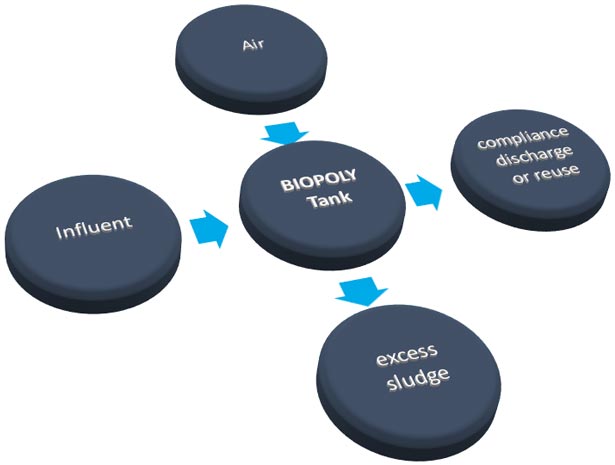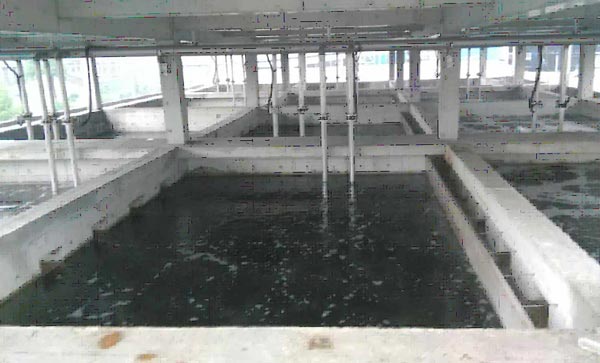BIOPOLY process is a new type of biological aerated filter developed by Shanghai Hanyuan Engineering and Technology Co., Ltd. on the basis of improving and optimizing the traditional BAF process. It is named as a new lightweight suspended filler BioPolyurethane ( composed of polyurethane architecture and powdered activated carbon coating ).
BIOPOLY process adopts up-flow biological filter, which is a sewage treatment process with reliable operation, high automation, good effluent quality, strong impact resistance and energy saving. Through the application of new technologies such as BioPolyurethane filler and special strains, the technical bottleneck of BAF process was overcome, the uneven distribution of water and air in BAF was solved, the mass transfer efficiency and volumetric loading rate were improved, and the removal efficiency of refractory pollutants was improved. The process flow is simple, and the operation and management are convenient. BIOPOLY has the function of removing BOD and SS and achieving nitrification and denitrification.
The sewage passes through the filter layer, and the pollutants contained in the water are intercepted by the filter layer, and are biodegraded and transformed by the attached filter material. At the same time, dissolved organic matter and specific substances are also removed, the resulting sludge is retained in the filter layer, and only the purified water passes through, so that complete biological treatment can be achieved in a closed reactor without setting a secondary sedimentation tank in the subsequent processing unit for sludge-water separation.
The bottom of the filter is equipped with water distribution pipe and sludge discharge pipe. The upper part is the filler layer, and the height is generally 2.5 ~ 3.5 m. In order to prevent the loss of filter material, the grid baffle is set up above the filter bed to facilitate maintenance. The upper space of baffle is clear water area.
In this process, a reflux pump can be set in the clear water area to pump the filter out to the water distribution corridor, and then return to the bottom of the filter to achieve denitrification. There is no such reflux system in the process without denitrification requirement. The air supply system of the filter is divided into two sets of pipelines. The aeration system is placed at the bottom of the filter ( mainly by the aeration fan to provide oxygenated aeration ), one of which is for daily aeration, and the other is the backwash air pipe. The equipment and control requirements of the system are greatly reduced without setting backwash pumps and backwash blowers alone.
The light suspended filler used in BIOPOLY process can reduce the head loss of the filter bed, and the active groups inoculated on the filler surface can accelerate the formation of biofilm. The powdered activated carbon composited by coating technology greatly improves the specific surface area of the filler, and the large specific surface area is conducive to improving the total amount of biofilm. The core of BIOPOLY process is mainly BioPolyurethane light suspension filler.
BioPolyurethane lightweight suspension filler is made of hydrophilic polymer materials, the spatial structure is reticular, the specific surface area is greater than 10 × 104m2 / m3, the porosity is greater than 85 %, the wear resistance is strong, and the chemical performance is stable. The surface contains a certain number of active groups by modification. At the same time, the powder activated carbon is compounded by coating technology, and the specific surface area of the filler is increased by 200 %.
BioPolyurethane light suspension filler is a hydrophilic material, which is conducive to the attachment and growth of bacteria. The surface of BioPolyurethane lightweight suspension filler is rough, and the pore size of more than 50 % pores is greater than 0.5 μm, which is very beneficial to the attachment and growth of bacteria. The activity of bacteria is limited in a certain area, which ensures that bacteria do not lose and improves bacterial activity.
Increasing the ratio of large pores through the pore design of the filler can improve the permeability of the filler, achieve uniform distribution of water, improve mass transfer efficiency and oxygen utilization rate. Changing the ratio of permeable and closed pores can greatly increase the specific surface area of the filler and improve the microbial concentration. The experimental data show that the total microbial biomass of light suspended filler can reach 30 g / L.
 BIOPOLY tank aeration system. The tubular aerator is evenly arranged at the bottom of the pond to provide oxygen for microorganisms in the aerobic zone. The BIOPOLY tank needs to carry out backwashing and sludge removal regularly. The non-gravity backwashing is adopted, and only the gas backwashing is needed. Each single tank is backwashed alternately. When backwashing, increase the aeration rate of the single pond, and discharge the backwashing sludge wastewater through the backwashing drainage pipeline through the flow pushing effect of the influent. The backwash water consumption is about 1 % of the total treatment capacity.
BIOPOLY tank aeration system. The tubular aerator is evenly arranged at the bottom of the pond to provide oxygen for microorganisms in the aerobic zone. The BIOPOLY tank needs to carry out backwashing and sludge removal regularly. The non-gravity backwashing is adopted, and only the gas backwashing is needed. Each single tank is backwashed alternately. When backwashing, increase the aeration rate of the single pond, and discharge the backwashing sludge wastewater through the backwashing drainage pipeline through the flow pushing effect of the influent. The backwash water consumption is about 1 % of the total treatment capacity.
The wastewater of Zhejiang Textile Printing and Dyeing Co.,Ltd contains dyestuff, finishing agents, additives, oil agents, acids, fibers, sands, inorganic salts, etc. After air flotation, hydrolysis acidification and biological aerobic treatment, most suspended solids, ammonia nitrogen, volatile phenol and sulfide can be removed. However, the effluent still does not meet the company reuse requirements of printing and dyeing wastewater. According to the company current situation, it is proposed to reuse the wastewater after biochemical treatment. BIOPOLY process is used for advanced treatment, and the treated water quality meets the reuse requirements.
Operating data are as follows:
| No. | Index | Influent Requirement | Effluent Requirement | Operating Data
Average Data in June |
Unit | |
| Influent | Effluent | |||||
| 1 | Influent Amount | <5000 | 3056 | t/d | ||
| 2 | CODCr | <120 | <80 | 118 | 73 | mg/L |
| 3 | BOD5 | <5000 | – | mg/L | ||
| 4 | NH4+-N | <15 | <5 | 9 | 0 | mg/L |
| 5 | NO3−-N | <5 | mg/L | |||
| 6 | TN | <25 | <20 | 21 | 5 | mg/L |
| 7 | Color Yield | 40 | <20 | 60 | 15 | time |
| 8 | SS | <20 | <5 | 27 | 2 | NTU |
